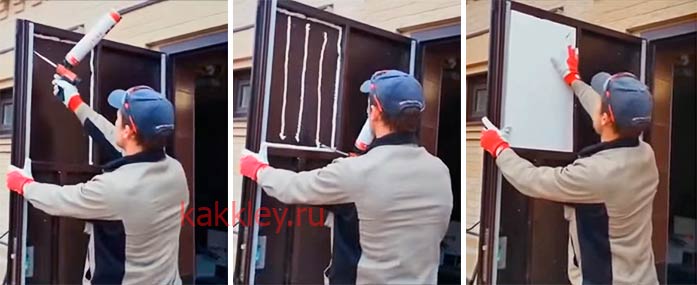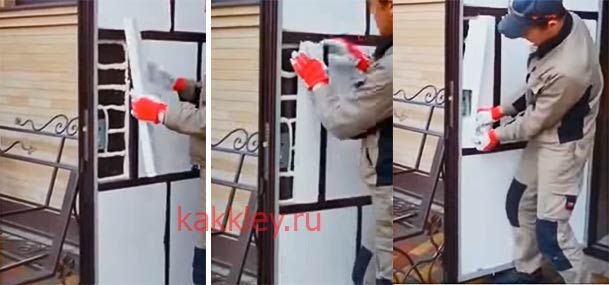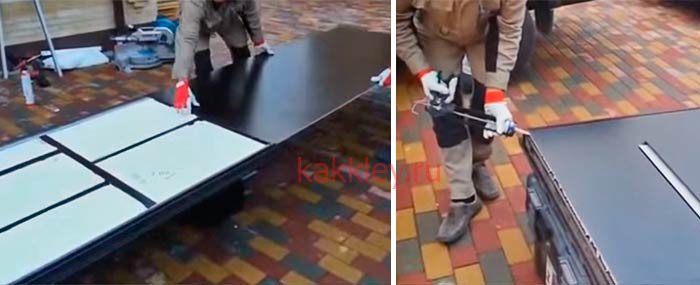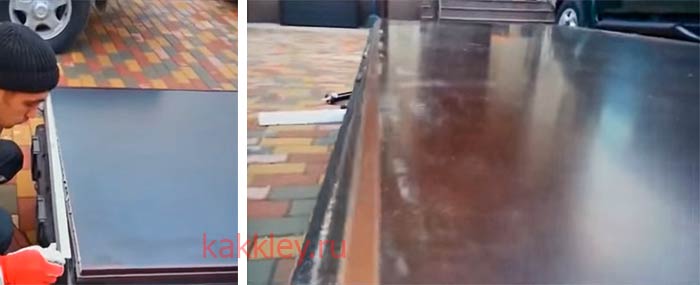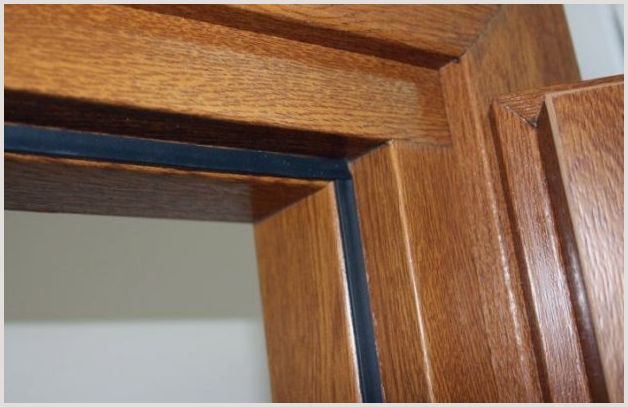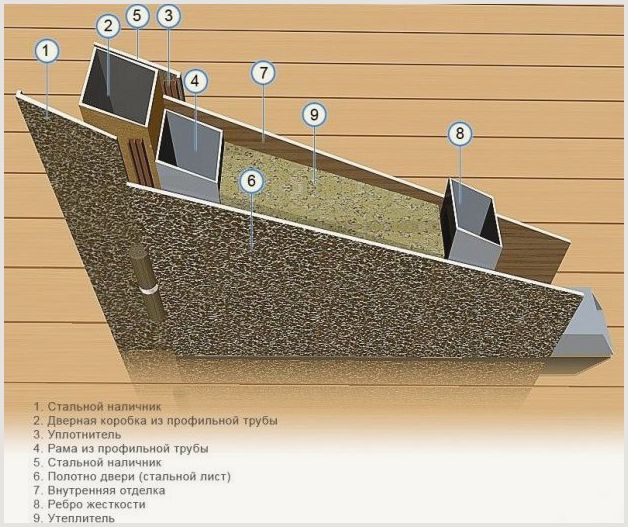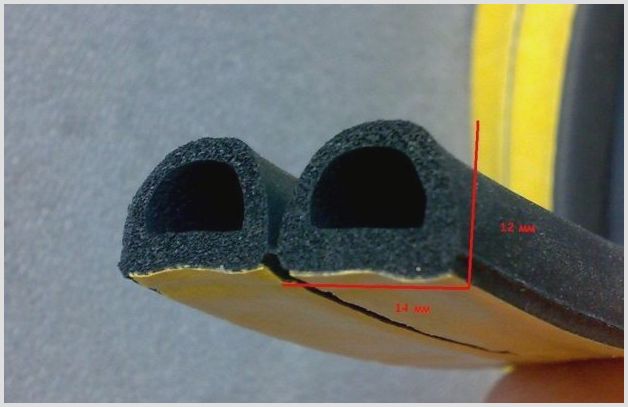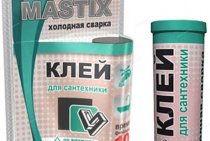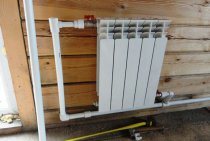Features of the choice of door insulation
The reasons for heat loss are different: from skewed door leaf and insufficient sealing, to insufficient quality of the material. If replacing the door is not included in the plans, then the only right solution that will help save 25-30% of heat energy is door insulation, the nuances of which will be discussed.
The nuances of installing door insulation
You will have to tinker with the insulation of a metal door.
Algorithm for mounting insulation on a metal door:
- If the door is collapsible, it is unwound, having previously removed it from the hinges and dismantled the locks with handles. In the case of welded seams, they are separated using an angle grinder.
- Laying the insulation in an empty box (if necessary - blowing with mounting foam).
- Assembly of the door frame.
In the case of a wooden door, the jamb is first leveled and the hinges are strengthened.
Stages of fixing insulation on a wooden door:
- The doors are removed from the hinges, the fittings are untwisted.
- The canvas is laid on a flat surface, after which a heater is attached to it with liquid nails or glue.
- The upholstery is reinforced with an interval between nails of 30 cm.
Each material has design and installation criteria that help you choose the right insulation.
Manufacturers and prices
Today, in every hardware store, door insulation is presented in a wide range. Each manufacturer provides its own options for a heat insulator, which will differ in cost, type of filler and other characteristics.
You can buy high-quality door insulation from the following manufacturers:
- Aviora - price 150 rubles.
KIM TEC - price 76 rubles.
Ultima - price 130 rubles.
Largo Enterprise - price 95 rubles.
Don - the price is 120 rubles.
Self-adhesive insulation tape for door construction is a unique opportunity to eliminate heat loss and make the room cozy and comfortable. Today, the range of products under consideration is very wide, so you can choose your ideal version of insulation. In addition to choosing a heat insulator, it is necessary to assess the complexity of the problem in order to understand which of the installation options presented is appropriate to use in a particular case.
Self-adhesive seal Remontix D 100 1X
Self-adhesive window tape, L 10 m, 50 mm, SIBRTECH, 93.
Seal TESA E-profile rubber white
Self-adhesive door seal D 100m profile (9x.
Sealant for windows self-adhesive, 5x8 mm, 19 m SibrTe.
Self-adhesive insulation, 5x16mm, 12m (art. 40903-05-16.
Door insulation 8mmx4mx19mm
Sealant for windows, doors and furniture Remontix, profile.
Sealing tape interflange self-adhesive 5*10 (1.
Sealant for doors KIM TEC Sanok industrial D-pro.
insulation for windows foam rubber 20x15 mm b / class. pack 10m
Sealant self-expanding self-adhesive, .
Washable self-adhesive tape for window and door insulation.
Self-adhesive insulation 5x16mm 12m 40903-05-16
Sealant for windows, doors and furniture Remontix, profile.
Tape insulating self-adhesive for windows and doors Avi.
Sealant rubber self-adhesive, profile "E&qu.
Self-adhesive insulation, 5x8mm, 19m
Self-adhesive insulation 5x8mm 19m 40903-05-08
Door insulation 8mmx4mx19mm
Tape for windows self-adhesive, L 10 m, 30 mm SibrTeh [93.
seal rubber d-profile 10m white s/cl
Thermal insulation tape for windows and doors AVIORA 302-086
Door insulation 8mmx4mx19mm
Roll Penoterm Penoprof Porileks NPE LF type C 0.6m 5mm
Insulation self-adhesive isolon 4*7mm 15m
Sealant self-adhesive Sibrtech, profile "D"
Sealant industrial self-adhesive ZUBR "ekspe.
Self-adhesive tape K-Flex ST 3mm*50mm*15m
Rubber self-adhesive seal profile D 12×10 mm.
Self-adhesive insulation, 5x8mm, 19m, 40903-05-08
Sealing for windows and doors Sibrtech, self-adhesive, p.
Washable self-adhesive tape for window and door insulation.
Sealant for windows, doors and furniture Remontix, profile.
Washable self-adhesive tape for window and door insulation.
Self-adhesive insulation, 5x16mm, 12m Without tm, 40903-05-.
Sealant self-adhesive Sibrtech, profile "E"
Self-adhesive insulation for windows and doors 5mmx8mmx19m.
Self-adhesive insulation, 5x16 mm, 12 m
Sealant self-adhesive Sibrtech, profile "D"
Sealant self-adhesive Ultima, profile "P".
TYTAN Professional sealant self-adhesive "E&qu.
Sealant self-adhesive Ultima, profile "E".
Self-adhesive seal Remontix D 100 1X
Self-adhesive door seal D 100m profile (9x.
seal rubber d-profile 10m brown s/cl
sealant for doors and windows self-adhesive 100m. D pro.
Sealant self-adhesive Sibrtech, profile "P"
Tape for windows self-adhesive L 10 m 40 mm SIBRTEH 93868
Sealing for windows and doors Sibrtech, self-adhesive, p.
Self-adhesive insulation, 5x16 mm, 12 m
Self-adhesive window seal, 5 x 8 mm, 10 meters.
Anti-thresholds, Trelleborg seals Self-adhesive seal.
Self-adhesive insulation, Russia, 40903-05-16
Thermal tape for windows, polyethylene foam, self-adhesive.
Self-adhesive insulation for windows and doors 8mmx8mmx14m
Rubber self-adhesive seal profile D 9×8 mm 15.
Window seal, self-adhesive, 8 mm x 4 mm x 18 m
OEM Self-adhesive seal D-profile 12mm 10mm 50m
OEM Self-adhesive seal E-profile, 9mm 4mm 150mm
Tape insulating self-adhesive for windows and doors Avi.
Tape for windows self-adhesive, L 10 m, 40 mm SibrTeh [93.
Self-adhesive door seal. D profile (9x7.5mm.
Insulation for windows "Proffi", self-adhesive.
Sealant industrial, self-adhesive, black, D-prof.
Mineral wool
Mineral wool is produced from silicate rocks. High noise and heat insulation characteristics of the product are determined by the fibrous structure. Mineral wool is environmentally friendly, non-flammable, resistant to moisture penetration, the influence of temperature fluctuations, is not afraid of chemicals, and is also characterized by moderate cost.
The main disadvantages of the material are subsidence under its own weight, resulting in the formation of voids. To avoid this, the installation of additional stiffeners that can keep the insulation from slipping helps.
In any house or apartment, most of the heat leaves through the front doors. Only competent insulation of the door structure will solve this problem. If you choose the right heat-insulating material, you can reduce heat loss by 25-30%. But here the choice of insulation is determined taking into account what material this or that door was made of. Further in the article you will find which self-adhesive insulation is better to choose, its descriptions and characteristics.
Application
Door insulation can be glued in several ways. To understand which one suits you, you need to consider them separately.
Around the perimeter of a metal door
If the door does not fit snugly against the door frame, then gaps will occur during its closing. It is because of them that cold air will come in from the street.
To solve these problems, it is necessary to evaluate the evenness of the door frame and the operation of the hinges. Maybe the reason for the penetration of cold lies in the distortion. After that, mount insulation around the perimeter of the box. It will have a strip of rubber or foam rubber. Such insulation can be used for wooden, metal and metal-plastic sheets.
On the video insulation around the perimeter of the door frame:
The advantages of the method include ease of installation, low cost of materials and efficiency. The disadvantages of such an installation include low durability.
door frame insulation
To insulate the door frame, it is necessary to close up its internal space using the selected heat insulator. This type of insulation is often used for iron structures. It is this door that quickly cools and freezes.
The insides of the door are represented by several compartments. They are separated by stiffeners, lock design and other elements. Put the material inside the box.At the same time, it is worth using a heater that is light, reliable and resistant to fire.
Most often, mineral wool, polystyrene are used for these purposes. In addition to thermal insulation, the inside of the box must be pasted over with a polyethylene film. Blow out all cracks with sealant.
Video: rubber insulation tape for the front door
On the video self-adhesive insulation for metal doors:
The advantages of this method include high efficiency, low price of materials and excellent thermal insulation properties that the entire box receives. The disadvantages of thermal insulation can only be attributed to the fact that it is very difficult to open the door without the help of a specialist.
External door insulation
With this option of insulation, a mineral wool insulation is mounted on the outer side of the door structure. In addition, you need to attach a protective coating. For these purposes, you will have to use leatherette or a leather substitute. Today you can also buy material made of genuine leather.
You can do this kind of work yourself. Before insulating the entrance structure from the outside, it is necessary to assess its integrity. Be sure to also calculate where the peephole will be located. Using this option for installing insulation, it is possible to save personal time and not pay money for unnecessary material.
On the video, the external insulation of the door:
The advantages of external door insulation include ease of installation, cost-effectiveness and the ability to eliminate external design defects. But the disadvantages of a heat insulator are that when using cheap material, it deteriorates very quickly. To solve this problem, you should not save on material, but immediately buy a reliable and durable insulation.
You may also be interested in learning about what Polynor spray insulation is and where it is used, you can find out from the article.
This information will help you understand what it looks like and how foil insulation is used under a warm floor.
The choice of self-adhesive insulation for entrance doors
On the shelves of hardware stores there are several options for self-adhesive heaters that are suitable for front doors. All of them are tape with an adhesive edge.
The tape itself can be made from:
1. Rubber-based seal.
Rubber insulation for the front door can be called universal. It is not afraid of moisture and temperature changes, exposure to chemicals, it is easy to install.
Service life - from 3 to 10 years. In one package there are about 12 meters of material, the cost of the tape is 150-250 rubles.
2. Foam tapes.
Of the advantages of foam rubber, it is worth highlighting that it is easy to stick and affordable price.
However, the disadvantages outweigh the advantages:
- weak thermal insulation effect,
- short service life.
The cost of one package is about 100 rubles.
3. Polyvinyl chloride. These tapes are valued for their high reliability, they are not afraid of temperature changes from -50C to +70C. Their service life is up to 20 years. Their main disadvantage is the high cost, but given the durability of the material, the price pays off with interest.
4. Silicone. Such heaters are environmentally friendly, but due to the characteristics of the material, they are mainly used for interior doors.
5. Izolon. Another adhesive-based material. It is made from polyurethane foam. It is sold in rolls, it is convenient to glue it. The cost is from 10 to 160 rubles per square meter.
We take into account the nuances of the material of the door
1. When choosing a seal for a metal front door, follow these recommendations:
- Do not purchase foam rubber bands, it is not recommended to use them for entrance metal doors, since the material will not withstand frequent opening of the door and will have to be replaced in half a year.
- Lightly press on the base of the insulation. If it quickly restores its shape, then it can provide good tightness.
- When choosing a color, give preference to black seals, they are considered to be of better quality.
- Make sure the adhesive backing is not past its expiration date.
2. Fitting a wooden door to a door frame is always accompanied by difficulties, which is associated with the individual characteristics of natural material.
When wet, dry, temperature changes, the tree is deformed, so cracks are constantly formed.
To eliminate gaps, it is recommended to stick silicone and rubber heaters that fit snugly to the surface. Isolon has also proven itself well.
If the task is to save money, you can limit yourself to foam rubber, but it is important to understand that it will not last long
Instructions - how to properly glue the seal on the door
- Carefully remove the old insulation with the help of tools. In our example, the strips are firmly attached to the door frame. We also remove all nails, staples and buttons. This step is mandatory, otherwise the door will not close after replacing the insulation.
- We use a heater with a gap of 1-3 mm. In the upper part we glue a strip of material along the length a little more than necessary. So we get a neat design.
- We check whether the material is glued evenly. Cut off the bottom with a knife. In the upper part, we glue the sealant strip so that it overlaps the vertical strip. We do the same at the bottom of the box.
As a result, we obtain two strips of sealant with a beveled cut, connected at an angle of 45 ° C. This design will retain heat for about 5 years.
We insulate the entrance metal door with foam sheets
If you have a metal door, study it, is it possible to remove the inner metal removable sheet, often it is attached to the top and bottom of the door with self-tapping screws on the corners.
We act as follows:
- We remove the removable sheet.
- We go through the inner corners with sealant. We put insulation in the door leaf, for example, foam. Each piece should match the size of the cells in the door.
- We lay the insulation in an even layer. If this is not possible, we fill the voids with mounting foam (excess foam is removed).
- We put the removed sheet back. Now the door is insulated and ready for use.
>
The traditional way of sealing is inconvenient
Usually, special self-adhesive seals are sold for insulation. They are proposed to be glued between the door and the frame at the points of their contact. But this approach has shown to be ineffective. The seal installed in this way is very sensitive to distortions of the door. The slightest distortion leads to a loss of tightness, since the seal no longer fits. Installing such a tape is also not easy. Only if the door stands perfectly, you can simply glue the strip. Otherwise, the distance between the door and the frame is different in different places. So you have to put something under the sealing tape to ensure a secure fit.
The disadvantages of such insulation
The only drawback of the method is that by accidentally touching the seal, it can be torn off. Yes, okay. It's not hard to stick it in place.
Korovin Sergey Dmitrievich
Master of Architecture, graduated from the Samara State University of Architecture and Civil Engineering. 11 years of experience in design and construction.
Warmth and comfort in the house are the main tasks facing every owner of their own living space.
Particular attention is paid to the front door, as it is in direct contact with the street. And in the cold season, heat is able to leave the room through the doorway.
To avoid unpleasant consequences, the front door should be insulated. You can do this work yourself. But before insulating a wooden door in a private house, you should prepare everything you need for this.
Wood door seals are quite a popular option.
To seal a wooden door, you can glue any of the profiled or solid rectangular (square) materials indicated in the previous chapter. Of course, from those that are intended for this installation (self-adhesive and installed using glue). For good attachment security, sealing inserts can be additionally screwed through the washers with self-tapping screws. Installation locations are the same as for a metal door.
And you can make the seal with a material of your own manufacture - in other words, with rollers. We wrap any material for insulation (foam rubber is often used) in leatherette or vinyl leather. This is the roller. You need to install it in the middle of the apartment (house). Installation is performed:
- On the box - along its inner surface on the left, on the right side and on top at a small distance from the door. It is necessary to achieve that the door, when closing, fits snugly against the rollers. Rollers are not installed on the threshold, due to the fact that they wear out in a short time.
- And on the door - to its lower edge.
The fastening of the rollers is done with decorative nails along that side of them, which is opposite to the place where the leatherette is bent twice around the foam rubber.
Entrance door insulation
Regardless of the effectiveness of sealing by the above methods, a variety of flashing strips are now used for wooden doors:
- wedge-shaped rails;
- external rails;
- plastic tubes inserted with the help of specialized clamps on them into the grooves;
- iron and plastic strips with a brush or rubber band;
- and the rest.
The wedge-shaped rail is placed on the box in the corner between the porch and the surface opposite the frame of the closed door. Moreover, the installation is done exclusively for the upper part of the opening and its sides. Before installation, the rail is cut to the size of these installation locations. For docking points (at the top of the opening), they are cut at an angle of 45o. And you need to cut the rail in the places with which it will adjoin the door lock and hinges. After we hammer it with nails.
The outer rail is placed on the door stop of the box (in other words, as if it were a continuation of the vestibule). It is also cut to fit the opening for its top and sides. Install using self-tapping screws or self-drilling screws. After a qualified installation, a paper sheet must pass between the rail and the closed door.
There are also strips that are mounted on the outer front side of the door, closing the gap in the opening. They are also first cut into segments of the required size. After they are attached to the door, which at the same time must be closed
It is especially important to carry out installation with rust-resistant self-tapping screws - rusted fasteners usually provoke rotting of a wooden door
The bottom of the doorway is sealed with other types of rails, the method of using which is also slightly different. Some flashing strips are nailed to the threshold, while others are nailed to the inside face of the door. They are all cut to the width of the bottom of the doorway, fixed with self-tapping screws.
Flat threshold products are an aluminum or plastic base, to the bottom of which a brush or a rubber plate is fixed. Such slats are usually placed on both exterior and interior doors. After high-quality installation, the clearance between the flat bar and the threshold should be small. However, the rail should not interfere with the easy free opening and closing of the door. Certain types of flat rails are equipped with specialized (elongated) holes for screws, thanks to which you can adjust the height of their installation.
Threshold products with a plastic shield protect the intrusion into the living area (house) of unsaturated air. Basically, they are mounted on an external door.
Combined strips consist of 2 metal strips, one of which has a nylon brush attached. A product without a brush is installed on the threshold.And a rail with a brush - on the door. The bar on the threshold is equipped with a specialized groove that prevents water from penetrating into the middle of the room.
After high-quality installation of the combined strip, the hanging edge of the strip installed on the threshold should “look” towards the premises. And the door lining brush should exert a slight pressure on the threshold bar.
How to properly insulate your front door
Another approach is reliable. It is shown in the picture.
The seal is not installed between the door and the jamb, but on the jamb, so as to fit snugly against the door. In this case, the seal has a greater degree of freedom and, accordingly, provides tightness with greater deformation of the door. This method of installation does not depend on the initial position of the door relative to the frame, since when gluing the seal can be installed exactly in the position that will ensure sealing.
I use Moment glue for this work. The work is done like this. The door frame in the place where the seal will be glued is lubricated with glue. The sealing tape itself is cut to the desired length. The edges are cut at 45 degrees to fit with other strips of tape. The side that will be glued is also smeared with glue. The glue is aged for 15 minutes. Next, the door closes. The tape is superimposed on the place smeared with glue so that it fits snugly against the door, and is strongly pressed by hand for 2 to 3 seconds. Further, for complete drying, the glue is aged for a day.
It is convenient to use a rubber tube as a sealing tape (only rubber should be stable, not decompose and not get dirty) or a special round-section sealing cord made of polyethylene foam.
How to insulate the front door
The guarantee of future comfort depends on the chosen material, for the sake of which the insulation was started. And if a few decades ago only felt, foam rubber and dermantin were available, today the choice is much greater. And here is what the manufacturers offer:
- mineral wool;
- Styrofoam;
- Izolon;
- Styrofoam.
Mineral wool, like polystyrene, is most often taken as the basis for insulation for metal door panels. Both materials perfectly retain heat indoors and are not affected by microorganisms. Mineral wool is also worth noting because no rodents will spoil this insulation.
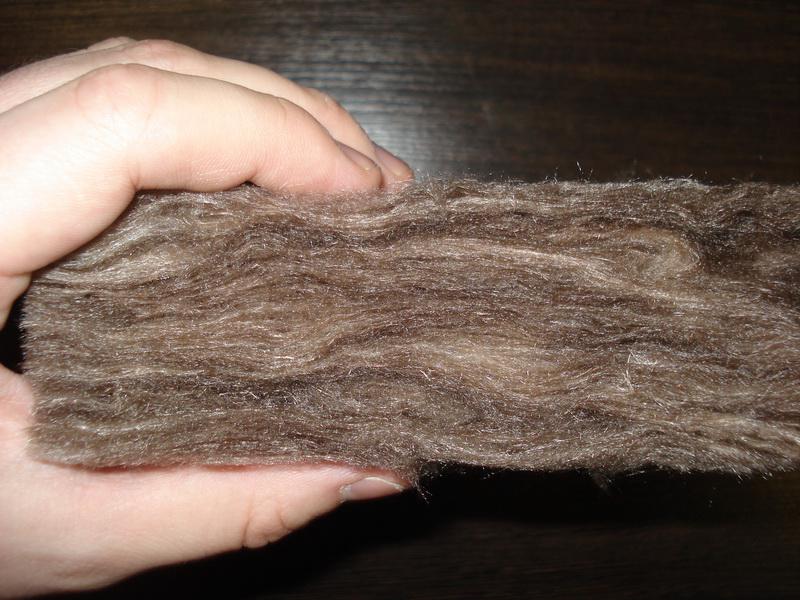
But these materials have some restrictions on their use.
The use of isolon is more justified in order to achieve the goal of retaining heat. This material is made on the basis of foamed polyethylene, which gives it a minimum thermal conductivity. The advantages of the material include the fact that a canvas with a thickness of 10 - 15 mm will be enough for work. This allows you to maintain an attractive appearance of the door leaf, without thickening it and not making it bulky.
 Izolon has low thermal conductivity
Izolon has low thermal conductivity
Expanded polystyrene has excellent performance. A door insulated in this way will become a reliable and safe barrier between a warm house and a cold street. Among the advantages of expanded polystyrene, its incombustibility should be highlighted. When a flame occurs, it will gradually disappear on the surface of this material.
For inexpensive insulation, you can always use foam rubber. The material is convenient in all respects and for a beginner home master it will be a real find. Foam rubber will forgive the mistakes made and allow them to be painlessly corrected.
Where and how to start preparation work
First, inspect the door and box. If they already have some kind of seal that has ceased to perform its own functions, then it must be dismantled. Then, if necessary, we perform pre-cleaning of surfaces where there was obsolete material, removing its remains. We use fine sandpaper for this.
After it is recommended if there is a need to adjust the door. Misalignment will cause uneven fit and seal wear. The different size of the gaps between the frame and the door below and above, on the right and on the left will also lead to this if the material of the same thickness is selected for the entire opening. Or you will have to choose a seal for each side of the opening. The critical value of distortion and the difference in the size of the slots is 1–1.5 mm. If they are larger, then a great option is to remove them by adjusting the door. It happens that the performance of this operation eliminates the reason why it was decided to seal the opening, and there is no need for such work.
Diagram of the door structure
Now you need to decide on the installation location and type of seal. It may depend on which part of the door or frame needs to be measured in order to find out the required amount of material.
Why is it blowing from the front door
After that, we measure the perimeter (or it is necessary only in one place the height and width, and then add and multiply by 2) of the contour on which the sealing inserts will be placed. This is the entire length of the required material. But it is best to take with a margin, based on the place and installation method.
After, if the seal is intended to be installed in one of the slots between the door and the frame, it is necessary to determine its required width and thickness. With the first size is clear. It is detected by measuring the width of the installation site.
To determine the thickness, ordinary plasticine is perfect. We sculpt it on the box at the site of the upcoming installation of the material and close the door. After we open it and measure the thickness of the flattened-lubricated plasticine. This will be the required height of the sealing insert. However, this is the thickness of the material in the compressed state when the door is closed.
You need to take the seal a little thicker. In this case, it is necessary to consider what materials the insert is made of, as well as its density, rigidity and reliability. For example, an overly thick foam pad may soon simply tear, and a rubber one will interfere with the door closing perfectly and bursting it, which will put an additional load on the lock and hinges, thus reducing their period of operation. And if the insert is not thick enough, then gaps may remain somewhere.
New door seal
If the size of the gap on the left, on the right side, above and below is different and radically different, then it is necessary to measure the thickness with plasticine for each of these sides and, perhaps, take material with a corresponding different height. For wooden unadjusted (skewed) doors, in case of sealing with planks along the gap, it may generally be necessary to adjust at least 2 extreme points of each side.
You need to purchase sealing inserts in whole parts of the required total length for absolutely all sides or for any of them if it needs to be cut. And in any case, you should not use some pieces, and especially trimmings of the seal. The result of such work will be low-quality sealing of the door, so if part of the material was damaged during poor cutting or installation, it is better to buy it in the required length.
After purchasing the material, we produce, if necessary, cutting (cutting) it into pieces of the required size. And only specifically before installation, if necessary, we do the preparation of the surfaces on which the sealant will be placed. We clean them of dirt and dust and remove relief irregularities. After that, if a sealant with an adhesive base (self-adhesive) or using glue is being installed, the metal door surfaces must also be degreased (with white spirit, thinner, acetone or gasoline), and the wood should be plastered with the smallest knife (zero).
After we begin the installation of the material.Corner compaction requires great attention, precision and accuracy. Here the biggest risk is to leave gaps. When laying the seal in pieces (2 short for the bottom and top and 2 long for the left and right side), loose joints may come out between them. And during installation, the full seal in the corners tends to wrinkle and/or may not attach tightly enough.
Tool
It is impossible to get the job done without the right set of tools. To create insulated wooden entrance doors you will need:
- Roulette and pencil;
- Stationery knife;
- Hacksaw;
- Hammer;
- Screwdriver;
- Smooth rail or metal meter;
- Mounter or nail puller;
- Construction stapler.
If necessary, this set can be expanded, but for most operations it will be enough. It should be noted that the hacksaw is easily replaced by an electric jigsaw. This tool allows you to complete the work with the same quality, but much faster. And if the house does not have a screwdriver, then you can take a simple drill. The main thing is that it has a reverse, which will allow, if necessary, to unscrew any self-tapping screw or screw.
In addition to the tool, it is necessary to prepare the sheathing material. For most door panels, it will be enough to use leatherette, which has an attractive appearance. This material has good characteristics and wear resistance, so the canvas does not need to be repaired for a long time.
And if you like to do everything with your own hands, then we recommend you instructions on how to make an entrance wooden door.

